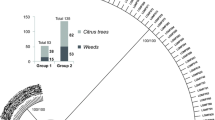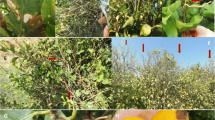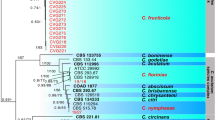Abstract
The genus Colletotrichum comprises a group of important fungal pathogens that can infect a wide variety of host plants worldwide. Postbloom fruit drop (PFD) of citrus plants is responsible for extensive crop losses annually, and is particularly detrimental to Brazilian citrus production. The disease was first associated with Colletotrichum gloeosporioides and subsequently linked to Colletotrichum acutatum. However, a new species, C. abscissum, was described in 2015 as the causative agent of PFD in Brazil. The species description used a small number of strains and the distribution of the pathogen remains unclear. The proportion of PFD caused by this species is also unclear, because both C. abscissum and C. gloeosporioides are associated with the disease as well. By analyzing sequences of the GAPDH intron region, we identified 227 isolates of Colletotrichum associated with PFD in orchards of São Paulo state, 172 isolates were identified as C. abscissum and 55 as C. gloeosporioides. Morphological characters and multilocus sequencing confirmed species C. abscissum was the only species in the C. acutatum complex associated with PFD disease in Brazil. Although described as sensitive to benzimidazole-based fungicides, 20% of C. gloeosporioides isolates were found in regions with high use of this class of fungicide. Evaluated strains exhibited resistance to this fungicide in vitro. Because previously described primers differentiate between C. acutatum and C. gloeosporioides complexes, but not the particular species associated with PFD, we proposed and validated primers for a single multiplex PCR that specifically distinguished the C. abscissum and C. gloeosporioides sensu stricto.




Similar content being viewed by others
References
Afanador-Kafuri, L., Minz, D., Maymon, M., & Freeman, S. (2003). Characterization of Colletotrichum isolates from tamarillo, passiflora and mango in Colombia and identification of a unique species from the genus. Phytopathology, 93, 579–587.
Agostini, J. P., Timmer, L. W., & Mitchell, D. J. (1992). Morphological and pathological characteristics of strains of Colletotrichum gloeosporioides from citrus. Phytopathology, 82, 1377–1382.
Altschul, S. F., Madden, T. L., Schaffer, A. A., Zhang, J., Zhang, Z., Miller, W., et al. (1997). Gapped BLAST and PSI-BLAST: a new generation of protein database search programs. Nucleic Acids Research, 25, 3389–3402.
Baroncelli, R., Zapparata, A., Sarocco, S., Sukno, S. A., Lane, C. R., Thon, M. R., et al. (2015). Molecular diversity of anthracnose pathogen populations associated with UK strawberry production suggests multiple introductions of three different colletotrichum species. PLoS One, 10(6), e0129140. doi:10.1371/journal.pone.0129140.
Bragança, C. A. D., Damm, U., Baroncelli, R., Massola Júnior, N. S., & Crous, P. (2016). Species of the Colletotrichum acutatum complex associated with anthracnose diseases of fruit in Brazil. Fungal Biology, 120(4), 547–561.
Brown, A. E., Sreenivasaprasad, S., & Timmer, L. W. (1996). Molecular characterization of slow-growing orange and key lime anthracnose strains of Colletotrichum from citrus as C. acutatum. Phytopathology, 86, 523–527.
Cannon, P. F., Damm, U., Johnston, P. R., & Weir, B. S. (2012). Colletotrichum – current status and future directions. Studies in Mycology, 73, 181–213.
Carbone, I., & Kohn, L. M. (1999). A method for designing primer sets for speciation studies in filamentous ascomycetes. Mycologia, 91(3), 553–556.
Chen, S., Cao, Y., Li, T., & Wu, X. (2015). Simultaneous detection of three wheat pathogenic fungal species by multiplex PCR. Phytoparasitica, 43, 449–460.
Cho, H. J., Hong, S. W., Kim, H., & Kwak, Y. (2016). Development of a multiplex PCR method to detect fungal pathogens for quarantine on exported cacti. Plant Pathology Journal, 32(1), 53–57.
Crous, P. W., Gams, W., Stalpers, J. A., Robert, V., and Stegehuis, G. (2004). MycoBank: an online initiative to launch mycology into the 21st century. Studies in Mycology, 50, 19–22.
Damm, U., Cannon, P. F., Woudenberg, J. H. C., & Crous, P. W. (2012). The Colletotrichum acutatum species complex. Studies in Mycology, 73, 37–113.
de Goes, A., Garrido, R. B. O., Reis, R. F., Baldassari, R. B., & Soares, M. A. (2008). Evaluation of fungicide applications to sweet orange at different flowering stages for control of postbloom fruit drop caused by Colletotrichum acutatum. Crop Protection, 27, 71–76.
de Hoog, G. S., & Gerrits van den Ende, A. H. G. (1998). Molecular diagnostics of clinical strains of filamentous Basidiomycetes. Mycoses, 41, 183–189.
de Menezes, H. D., Rodrigues, G. B., Teixeira, S. P., Massola, N. S., Bachmann, M. W., & Braga, G. U. L. (2014). In vitro photodynamic inactivation of plant-pathogenic fungi Colletotrichum acutatum and Colletotrichum gloeosporioides with novel PhenoThiazinium photosensitizers. Applied and Environmental Microbiology, 80(5), 1623–1632.
Fagan, H. J. (1979). Postbloom fruit drop, a new disease of citrus associated with a form of Colletotrichum gloeosporioides. Annals of Applied Biology, 91, 13–20.
Freeman, S., Katan, T., & Shabi, E. (1998). Characterization of Colletotrichum species responsible for anthracnose diseases of various fruits. Plant Disease, 82, 596–605.
Gardes, M., & Bruns, T. D. (1993). ITS primers with enhanced specificity for basidiomycetes – application to the identification of mycorrhizae and rusts. Molecular Ecology, 2, 113–118.
Guerber, J. C., Liu, B., Correll, J. C., & Johnston, P. R. (2003). Characterization of diversity in Colletotrichum acutatum sensu lato by sequence analysis of two gene introns, mtDNA and intron RFLPs, and mating compatibility. Mycologia, 95, 872–895.
Hall, T. A. (1999). BioEdit: a user-friendly biological sequence alignment editor and analysis program for Windows 95/98/NT. Nucleic Acids Symposium Series, 41, 95–98.
Huang, F., Chen, G. Q., Hou, X., Fu, Y. S., Cai, L., Hyde, K. D., et al. (2013). Colletotrichum species associated with cultivated citrus in China. Fungal Diversity, 61, 61–74.
Johnston, P. R., & Jones, D. (1997). Relationships among Colletotrichum isolates from fruit-rots assessed using rDNA sequences. Mycologia, 89(3), 420–430.
Johnston, P. R., Pennycook, S. R., & Manning, M. A. (2005). Taxonomy of fruit-rotting fungal pathogens: what’s really out there? New Zealand Plant Protection, 58, 42–46.
Kupper, K. C., Gimenes-Fernandes, N., & de Goes, A. (2003). Controle biológico de Colletotrichum acutatum, agente causal da queda prematura dos frutos cítricos. Fitopatologia Brasileira, 28, 251–257.
Lahey, K. A., Yuan, R., Burns, J. K., Ueng, P. P., Timmer, L. W., & Chung, K. R. (2004). Induction of phytohormones and differential gene expression in citrus flowers infected by the fungus Colletotrichum acutatum. Molecular Plant-Microbe Interactions, 17, 1394–1401.
Lardner, R., Johnston, P. R., Plummer, K. M., & Pearson, M. N. (1999). Morphological and molecular analysis of Colletotrichum acutatum sensu lato. Mycological Research, 103, 275–285.
Lima, W. G., Spósito, M. B., Amorim, L., Gonçalves, F. P., & Filho, P. A. M. (2011). Colletotrichum gloeosporioides, a new causal agent of citrus post-bloom fruit drop. European Journal of Plant Pathology, 131, 157–165.
Lima, J. S., Figueiredo, J. G., Gomes, R. G., Stringari, D., Goulin, E. H., Adamoski, D., et al. (2012). Genetic diversity of Colletotrichum spp. An endophytic fungi in a medicinal plant, Brazilian pepper tree. ISRN Microbiology. doi:10.5402/2012/215716.
MacKenzie, S. J., Legard, D. E., Timmer, L. W., Chandler, C. K., & Peres, N. A. (2006). Resistance of strawberry cultivars to crown rot caused by Colletotrichum gloeosporioides isolates from Florida is nonspecific. Plant Disease, 90, 1091–1097.
MacKenzie, S. J., Peres, N. A., Barquero, M. P., Arauz, L. F., & Timmer, L. W. (2009). Host range and genetic relatedness of Colletotrichum acutatum isolates from fruit crops and leatherleaf fern in Florida. Phytopathology, 99, 620–631.
Marques, J. P. R., Amorim, L., Silva-Junior, G. J., Spósito, M. B., & Appezzato-da Gloria, B. (2014). Structural and biochemical characteristics of citrus flowers associated with defense against a fungal pathogen. AoB Plants. doi:10.1093/aobpla/plu090.
McGovern, R. J., Seijo, T. E., Hendricks, K., & Roberts, P. D. (2012). New report of Colletotrichum gloeosporioides causing postbloom fruit drop on citrus in Bermuda. Canadian Journal of Plant Pathology, 34(2), 187–194.
O’Connell, R. J., Thon, M. R., Hacquard, S., Amyotte, S. G., Kleemann, J., Torres, M. F., et al. (2012). Lifestyle transitions in plant pathogenic Colletotrichum fungi deciphered by genome and transcriptome analyses. Nature Genetics. doi:10.1038/ng.2372.
Peres, N. A. R., Souza, N. L., Peever, T. L., & Timmer, L. W. (2004). Benomyl sensitivity of isolates of Colletotrichum acutatum and C. gloeosporioides from citrus. Plant Disease, 88, 125–130.
Peres, N. A., MacKenzie, S. J., Peever, T. L., & Timmer, L. W. (2008). Postbloom fruit drop of citrus and Key lime anthracnose are caused by distinct phylogenetic lineages of Colletotrichum acutatum. Phytopathology, 98, 345–352.
Petrini, O., Sieber, T. N., Toti, L., & Viret, O. (1992). Ecology, metabolite production and substrate utilization in endophytic fungi. Natural Toxins, 1, 185–196.
Pinho, D. B., Lopes, U. P., Pereira, O. L., Silveira, A. L., & de Goes, A. (2015). Colletotrichum abscissum Pinho & O.L. Pereira, sp. nov. Persoonia, 34, 236–237.
Potrykus, M., Sledz, W., Golanowska, M., Slawiak, M., Binek, A., Motyka, A., et al. (2014). Simultaneous detection of major blackleg and soft rot bacterial pathogens in potato by multiplex polymerase chain reaction. Annals of Applied Biology, 165, 474–487.
Raeder, U., & Broda, P. (1985). Rapid Preparation of DNA from filamentous fungi. Letters in Applied Microbiology, 1, 17–20.
Ronquist, F., Teslenko, M., van der Mark, P., Ayres, D. L., Darling, A., Höhna, S., et al. (2012). MrBayes 3.2: efficient Bayesian phylogenetic inference and model choice across a large model space. Systematic Biology, 61(3), 539–542.
Sreenivasaprasad, S., & Talhinhas, P. (2005). Genotypic and phenotypic diversity in Colletotrichum acutatum, a cosmopolitan pathogen causing anthracnose on a wide range of hosts. Molecular Plant Pathology, 6(4), 361–378.
Talhilhas, P., Baroncelli, R., & Le Floch, G. (2016). Anthracnose of lupins caused by Colletotrichum lupini: a recent disease and a successful worldwide pathogen. Journal of Plant Pathology, 98(1), 5–14.
Talhinhas, P., Gonçalves, E., Sreenivasaprasad, S., & Oliveira, H. (2015). Virulence diversity of anthracnose pathogens (Colletotrichum acutatum and C. gloeosporioides species complexes) on eight olive cultivars commonly grown in Portugal. European Journal of Plant Pathology, 142, 73–83. doi:10.1007/s10658-014-0590-7.
Tamura, K., Stecher, G., Peterson, D., Filipski, A., & Kumar, S. (2013). MEGA6: molecular evolutionary genetics analysis version 6.0. Molecular Biology and Evolution, 30(12), 2725–2729.
Templeton, M. D., Rikkerink, E. H. A., Solon, S. L., & Crowhurst, R. N. (1992). Cloning and molecular characterization of the glyceraldehyde-3-phosphate dehydrogenase encoding gene and cDNA from the plant pathogenic fungus Glomerella cingulata. Gene, 122, 225–230.
Thompson, J. D., Higgins, D. G., & Gibson, T. J. (1994). Clustal W: improving the sensitivity of progressive multiple sequence alignment through sequence weighting, position-specific gap penalties and weight matrix choice. Nucleic Acid Research, 22, 4673–4680.
Weir, B. S., Johnston, P. R., & Damm, U. (2012). The Colletotrichum gloeosporioides species complex. Studies in Mycology, 73, 115–180.
White, T. J., Bruns, T., Lee, S., & Taylor, J. W. (1990). Amplification and direct sequencing of fungal ribosomal RNA genes for phylogenetics. In: Innis, M. A., Gelfand, D. H., Sninsky, J. J., & White, T. J. (Eds.), PCR Protocols: A Guide to Methods and Applications (pp. 315–322). New York: Academic Press.
Whitelaw-Weckert, M. A., Curtin, S. J., Huang, R., Steel, C. C., Blanchard, C. L., & Roffey, P. E. (2007). Phylogenetic relationships and pathogenicity of Colletotrichum acutatum isolates from grape in subtropical Australia. Plant Pathology, 56, 448–463.
Woudenberg, J. H. C., Aveskamp, M. M., de Gruyter, J., Spiers, A. G., & Crous, P. W. (2009). Multiple Didymella teleomorphs are linked to the Phoma clematidina morphotype. Persoonia, 22, 56–62.
Author information
Authors and Affiliations
Corresponding author
Electronic supplementary material
Below is the link to the electronic supplementary material.
ESM 1
(DOCX 2169 kb)
Rights and permissions
About this article
Cite this article
Silva, A.O., Savi, D.C., Gomes, F.B. et al. Identification of Colletotrichum species associated with postbloom fruit drop in Brazil through GAPDH sequencing analysis and multiplex PCR. Eur J Plant Pathol 147, 731–748 (2017). https://doi.org/10.1007/s10658-016-1038-z
Accepted:
Published:
Issue Date:
DOI: https://doi.org/10.1007/s10658-016-1038-z




